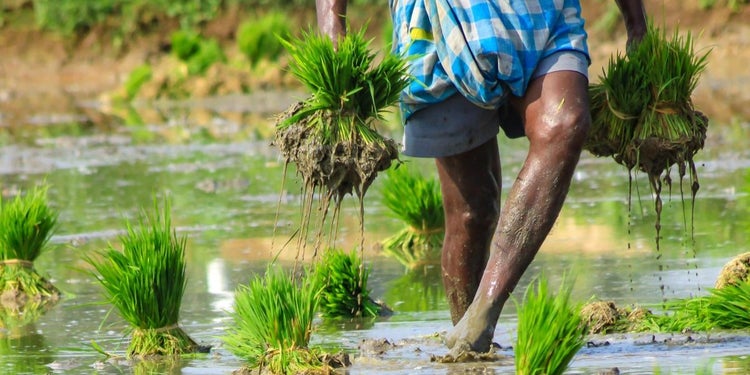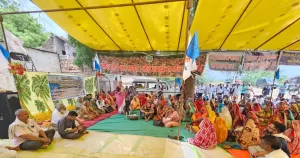Kabir Agarwal
While the broad consensus among economists was that the government needed to focus on putting money in the hands of those who are at the bottom of the pyramid, the 2020–21 budget has stayed away from making any such commitments.
The focus, in particular, had to be on providing a fillip to rural incomes as the current slowdown began in rural India, with rural wage growth showing a declining trend since 2014, and got particularly severe after demonetisation.
This is crucial too as the government has set itself the ambitious target of doubling farmers’ incomes by 2022 with 2015 as the reference year. But, even the first full budget of NDA 2 in July 2019, did not outline how this was going to be achieved.
The headline allocation for the rural sector in the 2020–21 budget is Rs 2.83 lakh crore, which is only 5.5% higher than the allocation last year and is barely able to keep up with inflation.
The two key schemes in place to provide income support to rural Indians are the Mahatma Gandhi National Rural Employment Guarantee Act (MGNREGA) and the PM Kisan Saman Nidhi (PM Kisan).
Finance Minister Nirmala Sitharaman’s budget has allocated 9.1% less for MGNREGA than what it expects to spend in 2019–20.
The finance minister has done the opposite under PM Kisan. In 2019–20, the government expected to spend Rs 54,000 crore till March 2020 against an allocation of Rs 75,000 crore. However, it has again allocated Rs 75,000 crore under the income support scheme. The scheme has stuttered in the last year and has been only been able to achieve only about 50% of its targets. The budget speech made no mention of addressing the issues which are plaguing the scheme.
The 16-point action plan that Sitharaman did announce for the agriculture sector is unlikely to result in any significant increased income in the near future. The plan talks about increasing agricultural credit, increasing food and fisheries production, eliminating foot and mouth disease, incentivising zero budget farming, improving transport facilities for perishable commodities. But that all this is mere empty talk is clear from the absence of any increased funding for agriculture in the Budget.
The important farm-based scheme, the Pradhan Mantri Fasal Bima Yojana (PMFBY), which the government had focussed on in the previous years, failed to get much attention this time in the budget speech. While allocation for PMFBY has increased by Rs 1,695 crore to Rs 15,695 crore, the government yet again has not addressed the issues which ail the scheme. The scheme is of limited benefit to farmers as the claim payments are delayed by months.
PM–Aasha which sought to compensate farmers when they sold their produce at less than MSP has seen a one-third cut in budget allocation, from Rs 1,500 crore last year to Rs 500 crore this year. To put this in perspective, the government estimates that it will spend Rs 4,000 crore on the National Population Register (NPR) exercise.
The cut would have been understandable had market prices been at par with MSPs. But, that has not been the case. The market prices have been consistently lower than MSPs for most crops except for wheat and rice.
The government has also reduced its allocation for food subsidy by a massive almost Rs 70,000 crore.
(Kabir Agarwal is a reporter for The Wire.)
In another article, Kabir Agarwal adds:
The Centre’s ambitious PM–Kisan scheme aimed at providing direct support of Rs 6,000 annually to farmers. The total amount of the scheme, which came into effect on December 1, 2018, is to be paid in three equal instalments of Rs 2,000 every four months.
When the scheme was launched, the government had estimated that 14.5 crore farmers will benefit under the scheme. However, in the one-year period between December 2018 and November 2019, only 7.62 crore or 52.6% farmers have received the first instalment; nearly 6.5 crore farmers got the second instalment; and 3.85 crore or 26.6% of the beneficiaries received all the three instalments; according to the data received from Ministry of Agriculture and Farmers’ Welfare in response to an RTI query.
Additionally, a report by The Wire staff says: Budget 2020 Fails MGNREGA Yet Again
Despite an acute funds crunch faced by the Mahatma Gandhi National Rural Employment Guarantee Act (MGNREGA) scheme, the budgetary allocation for the 2020–2021 financial year (FY) has only been increased marginally, from Rs 60,000 crore to Rs 61,500 crore. This increase, however, when compared with the revised estimate of FY 2019–20, is actually 9.1% less. In 2019–20, the revised estimate was Rs 71,002 crore.
For the last few years, rural distress has been visible across India. There has been a sharp rise in the number of people dependent on the rural employment scheme for their sustenance. The Centre however is curtailing funds to run the scheme.
According to the NREGA Sangarsha Morcha, a national platform of workers’ collectives, trade unions, organisations and individuals, an allocation of a minimum Rs 1 lakh crore is required to ensure a smooth running of the scheme.




